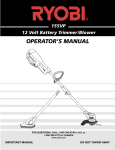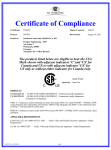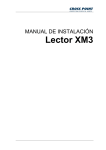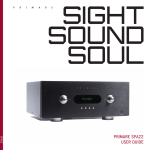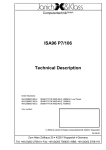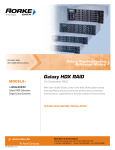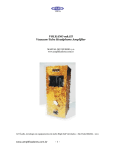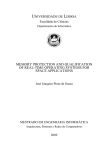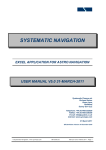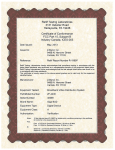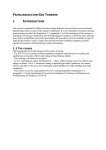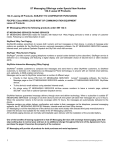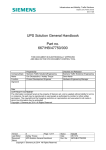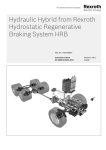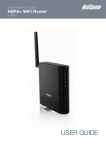Download X-PRO Series Designers manual for V1-6
Transcript
Designers Manual for X-PRO Series amplifier modules Preliminary edition – Subject to change ATTENTION: Safety instructions inside. Read this Manual before starting Design process. Designers Manual for Series X-PRO amplifier modules Version 1.6 Page 1 / 42 Contents X-PRO series specifications..............................................................................................4 How to test and measure...................................................................................................5 Recommended measurement tools and equipment............................................................................... 5 Measurement data and recommended test setup.................................................................................. 5 How to verify the power performance..................................................................................................... 5 How to verify the peak voltage performance.......................................................................................... 7 How to verify the frequency response.................................................................................................... 9 How to verify the THD+Noise............................................................................................................... 11 General design precautions............................................................................................ 13 Acoustic air pressure............................................................................................................................ 13 Water, rain, humidity and dust.............................................................................................................. 13 Shock, bump and vibration................................................................................................................... 13 General electrical design information............................................................................14 Pin designations..............................................................................................................15 Feature description.........................................................................................................16 Recommendation for 2.1 systems (Sub's and top's) .....................................................17 Connecting your signal processing.................................................................................18 Amplifier inputs............................................................................................................... 18 Power supply...................................................................................................................18 Chassis connection.........................................................................................................18 General features............................................................................................................... 19 Voltage clipping...............................................................................................................19 Current clipping...............................................................................................................19 Hard short circuiting........................................................................................................20 High frequency protection ..............................................................................................20 RMS power limitation......................................................................................................21 Dis read/protect ..............................................................................................................21 Clip limit off ch1-ch3........................................................................................................21 Temperature limiting....................................................................................................... 22 Temp reduction off..........................................................................................................22 Powerstage protection on Channel 1..............................................................................23 Thermal management...................................................................................................... 24 Heatsink design................................................................................................................25 General thermal considerations .................................................................................... 27 Fan control........................................................................................................................27 How to comply to safety requirements.......................................................................... 28 Earthing................................................................................................................................................ 28 Safety distances..............................................................................................................28 Marking of mains Earth connection internally in End-product. ....................................... 30 Safety temperatures........................................................................................................30 Safety markings on the product front plate...................................................................31 Safety instructions for admittance in the product's User's Manual ............................32 EMC and EMI design recommendations ........................................................................35 How to make proper earth decoupling designs..............................................................35 How to make proper chassis shielding...........................................................................36 How to make correct internal cabling..............................................................................36 Declaration on conformity with international EMC and EMI directives .....................37 Declarations for admittance in the product's User's Manual .......................................... 37 Mains connection information............................................................................................................... 37 Designers Manual for Series X-PRO amplifier modules Version 1.6 Page 2 / 42 Appendix 1.1: Cable production documentation (Amp. Out)...................................... 38 Appendix 1.2: Cable production documentation (Mains In) ........................................39 Appendix 1.3: Cable production documentation (40Pole I/O) .....................................40 Appendix 1.4: Cable production documentation (Fan Output) ................................... 41 Appendix 2: Suggested I/O board schematics..............................................................42 Designers Manual for Series X-PRO amplifier modules Version 1.6 Page 3 / 42 X-PRO series specifications Mechanical drawings of the X-PRO series mechanical profiles can be found on the Pascal Extranet: www.pascal-audio.com/extranet From below stated table electrical specifications on the X-PRO series are given. Power Ratings (RMS @ 1% THD) Load Channel 1 driven Channel 2 driven Channel 3 driven 16 Ω 800 W 200 W 200 W 8Ω 1550W 400 W 400 W 4Ω 2000 W 700 W 700 W Peak 3600 W 1300 W 1300 W Amplifier Output Circuitry 3rd Generation Class D - full bandwidth PWM modulator with ultra low distortion Output Voltage LF: 160 Vp / 320 Vpp unloaded MF,HF: 80 Vp / 160 Vpp unloaded Signal To Noise-Ratio LF: > 120 dB MF,HF: > 120 dB (A-weighted, 20 Hz - 20 kHz, 8 Ω load) THD+N (typical) < 0,05 % (20 Hz - 20 kHz, 8 Ω load, 3 dB below rated power) Frequency Response 20 Hz - 20 kHz ± 0,15 dB (8 Ω load, 1 dB below rated power) Damping Factor > 1000 (8 Ω load, 1 kHz and below) Protection Circuits Input limiter, short circuit protection, DC protection of output, under & over voltage protection, intelligent mains fuse protection, power stage overload protection, temperature protection of transformers and heat-sinks Readouts for DSP/Network On/Hibernation, Clip, Protect mode, Output voltage, Output current, Heatsink temperature Power Supply Regulated high efficient Switch Mode Power Supply Operation Voltage Universal Mains, 85-268V (dual voltage auto selection Power Hibernation Possibility for remote control start-up and shutdown - hibernation mode power consumption<2W Aux. Power for DSP ±15 V (150 mA), +7V (1 A, delivered by standby power supply) Fan Control +5V (Controlled by temperature thresholds) All specifications are typical values Designers Manual for Series X-PRO amplifier modules Version 1.6 Page 4 / 42 How to test and measure IMPORTANT: Read this section before connecting the Amplifier Unit to your measurement equipment and your test setup. The powerful PWM amplifiers and the 320Vpp voltage swing on the output terminals require special knowledge on how to test and measure to obtain correct data and not to damage the measurement equipment. Recommended measurement tools and equipment The following equipment list is recommended. Recommended measurement equipment Type Audio Precision AP SYS-2722 (or System 2) Audio Precision AP S-AES17 Audio Precision AP AUX-0025 Load Mains Generator Note Audio analyzer AES17 measurement filter option for AP system Switching amplifier measurement filter Minimum Ohmic load: 4 Ohms / 2000W (low inductive load) Only required for power measurements Measurement data and recommended test setup This section is a quick guide how to verify the 4 most important performance specifications: • • • • Power performance Peak voltage performance Frequency response Distortion (THD+N) measurement How to verify the power performance To get an optimal picture of the power performance of any kind of power amplifier you need to measure several different parameters under different conditions. Below you will find the measured power performance data and the test method used to obtain the given specification. Measured power performance (RMS @ 1% THD, 1kHz) per channel on 230 V AC mains generator Load Channel 1 driven Channel 2 driven Channel 3 driven 16 Ω 800W 200 W 200 W 8Ω 1550W 400 W 400 W 4Ω 2000 W 700 W 700 W Peak 3600 W 1300 W 1300 W Measured power performance (RMS @ 1% THD, 1kHz) per channel on 120 V AC mains generator Load Channel 1 driven Channel 2 driven Channel 3 driven 16 Ω 800W 200 W 200 W 8Ω 1500W 400 W 400 W 4Ω 2000 W 700 W 700 W Peak 3600 W 1300 W 1300 W The power performance measurement is measured with the AP SYS-2722. Use S-AES17 filter, the AUX0025 filter and connect the appropriate load. See illustration below. Designers Manual for Series X-PRO amplifier modules Version 1.6 Page 5 / 42 The setups below have been used on the Audio Precision analyzer to create amplifier input burst signals. The power performance results are viewed in the Data Editor in the Audio Precision analyzer. To open the “Data Editor” please press “Menu” and open the “Panels” section. To start the measurement press “Go” in the “Sweep” panel. Input voltage is set in the “Start” section of the sweep panel. For maximum output the input voltage should be in the range of 2.55 Vrms to reach maximum power output. Designers Manual for Series X-PRO amplifier modules Version 1.6 Page 6 / 42 How to verify the peak voltage performance Measured peak voltage (1000Hz; 1 cycle) per channel on low impedance 230V mains Load Channel 1 driven Channel 2 or 3 driven Channel 1/2 driven Channel 1/2/3 driven 16 Ω - 8Ω 160Vp 80Vp 155Vp/78Vp 150Vp/75Vp/75Vp 4Ω 120Vp 75Vp 120Vp/70Vp 115Vp/72Vp/72Vp Unloaded 165Vp 83Vp 165Vp/83Vp 165Vp/83Vp/83Vp The peak voltage performance measurement is measured with the AP SYS-2722 at the appropriate load. See illustration below. The setup below has been used on the Audio Precision analyzer to create the 1000 Hz 1 cycle burst. To obtain a properly clipped output signal on the amplifier unit, adjust the input voltage in the “Analogue Generator” to 5 Vp for Ch1, Ch2 and Ch3. Please see the graph next page for reference. To start the measurement press “Go” in the “Sweep” panel. Designers Manual for Series X-PRO amplifier modules Version 1.6 Page 7 / 42 To view the peak voltage measurement results open the “Data Editor” in the Audio Precision audio analyzer. Press “Menu” and “Panels” to enter the “Data Editor”. The output voltage measurement results can be viewed at 300 μsec and 800 μsec respectively in the “Data Editor”. The above figure can also be obtained or viewed on an oscilloscope. Always use differential probes when connecting the oscilloscope to the amplifier output. Differential probes must be able to handle ±190 V minimum. Designers Manual for Series X-PRO amplifier modules Version 1.6 Page 8 / 42 How to verify the frequency response Frequency responses are normally measured in 4 Ohms, 8 Ohms and open load using the Audio Precision SYS-2722. Use S-AES17 filter, the AUX-0025 filter and connect the appropriate load. See illustration below. The Audio Precision analyzer setup below is recommended. Please see the graph next page for reference. To start the measurement press “Go” in the “Sweep” panel. Designers Manual for Series X-PRO amplifier modules Version 1.6 Page 9 / 42 Frequency response example can be seen from the following two measurement graphs. Ch1 (High power channel) measurement can be seen below. Amplitude response in upper part of the graph, Phase response in the lower part of the graph. +30 +80 +29 +60 +28 +40 +27 d B g A +26 +20 +25 +0 +24 -20 +23 d e g -40 +22 -60 +21 -80 +20 20 50 100 200 500 1k 2k 5k 10k 20k 50k 100k Hz Note: Bump on graph in the range 100-200 Hz is due to Audio Precision relays switching Red graph: Green graph: Cyan graph: Open load 8 Ohm load 4 Ohm load Ch2 or Ch3 (Medium power channels) measurement can be seen below. Amplitude response in upper part of the graph, Phase response in the lower part of the graph. +30 +80 +29 +60 +28 +40 +27 d B g A +26 +20 +25 +0 +24 -20 +23 -40 +22 -60 +21 -80 +20 20 50 100 200 500 1k 2k 5k 10k 20k 50k 100k Hz Note: Bump on graph in the range 100-200 Hz is due to Audio Precision relays switching Red graph: Green graph: Cyan graph: Open load 8 Ohm load 4 Ohm load Designers Manual for Series X-PRO amplifier modules Version 1.6 Page 10 / 42 d e g How to verify the THD+Noise To obtain reliable and correct THD+N data it is necessary to use the Audio Precision AUX-0025 switching amplifier measurement filter with the Audio Precision SYS-2722 audio analyzer. The filter ensures that no out-of-band switching residual on the power amplifier output disturbs the distortion and noise spectrum measurement. The distortion measurement is performed with the AP SYS-2722. Use S-AES17 filter, the AUX-0025 filter and connect the appropriate load. See illustration below. The Audio Precision analyzer setup below is recommended. Set the frequency in the Analogue Generator window to 100 Hz; 1 kHz and 6.67 kHz respectively. Set “Append” in the “Sweep” panel to view all three graphs in one window. Please see the graph next page for reference. To start the measurement press “Go” in the “Sweep” panel. Designers Manual for Series X-PRO amplifier modules Version 1.6 Page 11 / 42 Distortion (THD+N) performance measurement. Both of the following graphs are measured with an 8 Ohm load. Below a THD+n@8Ohms measurement on CH 1 can be seen. 10 5 2 1 0.5 0.2 % 0.1 0.05 0.02 0.01 0.005 0.002 0.001 100m 200m 500m 1 2 5 10 20 50 100 200 500 1k W Cyan graph ~ 100 Hz; green graph ~ 1 kHz and red graph ~ 6.67 kHz. Below a THD+n@8Ohms measurement on CH 2 or 3 can be seen. 10 5 2 1 0.5 0.2 % 0.1 0.05 0.02 0.01 0.005 0.002 0.001 100m 200m 500m 1 2 5 10 20 50 100 200 500 W Cyan graph ~ 100 Hz; green graph ~ 1 kHz and red graph ~ 6.67 kHz. Designers Manual for Series X-PRO amplifier modules Version 1.6 Page 12 / 42 General design precautions When designing with the X-PRO series module it is important to observe the following precautions and recommendations for safe operation. Acoustic air pressure IMPORTANT: It is of absolute importance that the circuit boards are not being exposed to extreme vibration e.g when placed directly in the acoustical volume of the loudspeakers. In the case where the circuit boards are placed directly in the acoustical volume of the loudspeakers it must be secured that the mechanics is sufficiently rigid and stiff to avoid excessive vibrational levels at the circuit boards or at single components mounted on the circuit boards. Water, rain, humidity and dust The X-PRO series circuit boards are not protected against water, rain or excess humidity in any way and should under no circumstances be exposed to such. Proper design precautions must be taken to prevent dust and dirt from clogging up on the circuit boards. Dust and moisture are often the main cause for high voltage creepage and severe electric hazards. In case of vented amplifier chassis designs dust filters therefore must be added. Shock, bump and vibration The circuit boards are designed to be built into professional loudspeakers and subwoofers and have been shock, bump and vibration tested according to the following specifications: The product is unpowered during vibration test. After test the product is powered up to verify functionality. Test Random vibrations Bump 2-4 Hz Shock Force 3 grms 15 g / 16 ms 105 g / 16 ms Duration 3 x 20 min. / 6 directions 1.000 bumps / 6 directions 3 shocks / 6 directions The product is powered and loaded according to 1/8 th rated output power during vibration test. Test Sinusoidal vibrations 5-10 Hz Sinusoidal vibrations 10-150 Hz Random vibrations 10-20 Hz Random vibrations -3 dB/Oct. 10-150 Hz Force 2.5 mm excursion 1.5 g 0.7 g 1.0 g Duration 2 hours / 6 directions 2 hours / 6 directions 2 hours / 6 directions 2 hours / 6 directions IMPORTANT: It is important that proper design precautions are taken when designing the amplifier chassis and the loudspeaker cabinet to ensure, that the circuit boards are not exposed to excessive shocks, bumps or vibrations. Proper design precautions should always be taken to protect the amplifier unit against such stress. Designers Manual for Series X-PRO amplifier modules Version 1.6 Page 13 / 42 General electrical design information The X-PRO series PCB is fitted with a flat ribbon cable connector (ST700) for amplifier inputs, readouts and low voltage supply. Furthermore amplifier outputs are placed as connector (ST100, ST300, ST500). ST702 is used as a fan output and is described under the section “Fan Control” The connector type is described in the cable production documentation in Appendix 1. Please see the figure below for connector placements. The X-PRO series PCB is also fitted with one Molex type connector (ST900) for mains power connection. Please note that Live (L) and Neutral (N) is connected to the module through ST900. The Earth connection can be connected in ST900 (Pin 4) or directly to the chassis close to ST900 on an M4 stud/screw. The ST900 connector type for the mains input cable is described in the cable production documentation in Appendix 1. Designers Manual for Series X-PRO amplifier modules Version 1.6 Page 14 / 42 Pin designations Below the pin designations can be seen. Amplifier, Auxiliary power and main SMPS control +7 V Signal return Channel 1 Signal return Channel 2 Signal return Channel 3 Signal input channel 1 Signal input channel 2 Signal input channel 3 V Out monitor channel 1 V Out monitor channel 2 V Out monitor channel 3 I Out monitor channel 1 I Out monitor channel 2 I Out monitor channel 3 Temp monitor Clip Out channel 1 Clip Out channel 2 Clip Out channel 3 Circuit board connector and pin no. PX-PRO – ST700 pin 35, 36 PX-PRO – ST700 pin 39, 40 PX-PRO – ST700 pin 18, 19, 23, 25, 33, 34, 37, 38 PX-PRO – ST700 pin 1, 4, 7, 10 PX-PRO – ST700 pin 31, 32 PX-PRO – ST700 pin2 PX-PRO – ST700 pin 5 PX-PRO – ST700 pin 8 PX-PRO – ST700 pin 3 PX-PRO – ST700 pin 6 PX-PRO – ST700 pin 9 PX-PRO – ST700 pin 11 PX-PRO – ST700 pin 12 PX-PRO – ST700 pin 13 PX-PRO – ST700 pin 14 PX-PRO – ST700 pin 15 PX-PRO – ST700 pin 16 PX-PRO – ST700 pin 17 PX-PRO – ST700 pin 20 PX-PRO – ST700 pin 21 PX-PRO – ST700 pin 22 Dis read/Protect PX-PRO – ST700 pin 24 Disable Clip Limit off all channels SMPS Limit PX-PRO – ST700 pin 26 PX-PRO – ST700 pin 27 PX-PRO – ST700 pin 28 Temp reduction off PX-PRO – ST700 pin 29 Standby PX-PRO – ST700 pin 30 Feature +15 V -15 V GND (ref +/-15 V) Signal shield Designers Manual for Series X-PRO amplifier modules Version 1.6 Note Maximum current 150 mA Maximum current 150 mA See I/O board diagram for all pins Should be connected to ground at DSP board See I/O board diagram for all pins To be connected to signal source ground To be connected to signal source ground To be connected to signal source ground 4 V peak equals full output voltage (32dB gain) 4 V peak equals full output voltage (26dB gain) 4 V peak equals full output voltage (26dB gain) 10 V peak corresponding to 160 V on output 10 V peak corresponding to 80 V on output 10 V peak corresponding to 80 V on output 10 V peak corresponding to 30 A on output 10 V peak corresponding to 20 A on output 10 V peak corresponding to 20 A on output 0-10 V corresponds to 0 – 100 Degrees Celsius Open collector output Open collector output Open collector output Indicates amp channels switched off, either by DSP disable or by protection. Active low Switches all amp channels off. Active Low Active low Active low Disables soft volume reduction at high temperatures. Active Low Shuts down all circuitry except +7Vpowered. Active Low Page 15 / 42 Feature description Below a list of features can be seen. Amplifier channels feature description Feature Signal Shield Signal return Channel 1 Signal input channel 1 Signal Shield Signal return Channel 2 Signal input channel 2 Signal Shield Signal return Channel 3 Signal input channel 3 Signal Shield V Out monitor channel 1 V Out monitor channel 2 V Out monitor channel 3 I Out monitor channel 1 I Out monitor channel 2 I Out monitor channel 3 Temp monitor GND (ref +/-15 V) GND (ref +/-15 V) Clip Out channel 1 Clip Out channel 2 Clip Out channel 3 GND (ref +/-15 V) Pin No. 1 2 3 4 5 6 7 8 9 10 11 12 13 14 15 16 17 18 19 20 21 22 23 Dis read/Protect 24 GND (ref +/-15 V) Disable Clip Limit off all channels SMPS Limit Temp reduction off Standby +7 V +7 V GND (ref +/-15 V) GND (ref +/-15 V) +15 V +15 V GND (ref +/-15 V) GND (ref +/-15 V) 25 26 27 28 29 30 31 32 33 34 35 36 37 38 -15 V 39 -15 V 40 Note Should be connected to analog GND at Input/DSP-board To be connected to signal source ground 4 V peak equals full output voltage, 32dB gain should also be connected to GND at DSP-board To be connected to signal source ground 4 V peak equals full output voltage, 26dB gain should also be connected to GND at DSP-board To be connected to signal source ground 4 V peak equals full output voltage, 26dB gain should also be connected to GND at DSP-board 10 V peak corresponding to 160 V on output 10 V peak corresponding to 80 V on output 10 V peak corresponding to 80 V on output 10 V peak corresponding to 30 A on output 10 V peak corresponding to 20 A on output 10 V peak corresponding to 20 A on output 0-10 V corresponds to 0 – 100 Degrees Celsius Open collector output (active low) Open collector output (active low) Open collector output (active low) Indicates amp channels switched off, either by DSP disable or by protection. Active low. Open collector output. Switches all amp channels off. Active Low Active low Open collector (active low) Disables soft volume reduction at high temperatures. Active Low Shuts all power circuitry except +8 V. Active Low Maximum current 1.0 A (available in standby mode) Maximum current 1.0 A (available in standby mode) Maximum current 150 mA total on +15V Maximum current 150 mA total on +15V Maximum current 150 mA total on -15V Maximum current 150 mA total on -15V Note 1: The above auxiliary power ratings are given for a X-PRO3 module. The +/- 15V supply on the X-PRO2 module can deliver 50mA more on each supply rail. The +/- 15V supply on the X-PRO1 module can deliver 100mA more on each supply rail Designers Manual for Series X-PRO amplifier modules Version 1.6 Page 16 / 42 Note 2: All control inputs named “active low” are pulled up internally. To avoid voltage mismatch of the internal micro processor and external processors it is recommended to control these inputs with open collector or open drain outputs. See figure below. 1800 series module +5V Open Collector u-Processor External Control Recommendation for 2.1 systems (Sub's and top's) Channel 2 and 3 are single ended amplifier designs, which can pump back energy on the SMPS. Especially at low frequencies this can cause the voltage on the secondary side supply rails to rise. When channel 2 and 3 are loaded with top speakers and channel 2 and 3 is used to amplify low frequency signals please take following actions. Please invert channel 2 or channel 3. This will cancel out the supply pumping thereby not causing the SMPS to reach overvoltage protection levels. Tests can be carried out to verify that overvoltage protection is not engaged by disconnecting the load on channel 1 and driving the tops on channel 2 and 3 only. Designers Manual for Series X-PRO amplifier modules Version 1.6 Page 17 / 42 Connecting your signal processing Back plate w ith m etal chass is Ribbon cable Signal proce ss ing board 1800 se ries m odule Output PCB XLR 3 2 1 Chas Signal Shield Analog or Digital processing AMP in Signal Shield GND Proper decoupling of input signals and GND plane to chassis is essential for EMI compliance. AMP SGND GND GND GND Use a low drop regulator if 5V is needed. +5V Low Drop Regulator +3.3V Regulator +15V +15V -15V -15V +7V GND +7V GND Power supply GND is connected directly to chassis. Proper decoupling of output signals is essential for EMI compliance. Amplifier inputs All amplifier channels of the X-PRO series are using pseudo balancing to reject noise on cables etc. Pseudo means that there is an input and a separate ground return for each channel. The ground return named SGND on Figure 1 must be connected to the small signal ground on the signal processing board (GND on above figure). A proper place is at the DAC output buffer if a DSP is used. Some of the pins in the ribbon cable is used as shields for the inputs.These pins must be connected to the general ground of the processing board – E.G directly to the ground plane. Power supply When using the +7V output for DSPs etc. it is important to know that this voltage can drop down to approximately 6.1V in standby mode when loaded with 1A (it does drop less with lower output currents). It is therefore necessary to use a low drop out regulator if a stable 5V supply is needed. The LM1117 regulator is a good choice for currents under 500mA since it has a drop of around 1.2V. For higher currents a lower drop is required E.G LP38690 has a drop of 0.45V at 1A. Chassis connection The ground of the power supply inside the X-PRO series module is connected directly to the chassis with a low impedance connection for best EMI/ESD performance. Therefore we recommend using the grounding scheme of above figure. The ground from the ribbon cable is used for all parts on the processing board – of cause the designer shall split this GND properly between analog and digital parts around DACs, DSPs etc. as required. We also recommend connecting all shields of cables directly to the chassis for best EMI performance fx pin 1 of the input XLR connectors. All wires coming in and out of the box must be decoupled to the chassis with a small capacitor. It is normally a good idea to make a plane on the processing board connected directly to chassis ground via XLR screws and housing to get a low impedance high frequency connection. It is also a good idea to make a small PCB for filtering the loudspeaker outputs directly when they exit the box. This PCB shall hold small capacitors from all wires to the chassis. Again it is required to make a good high frequency connection from this PCB to the chassis. Designers Manual for Series X-PRO amplifier modules Version 1.6 Page 18 / 42 General features Voltage clipping When the amplifier reaches output voltages close to the powerstage rail voltages, the output voltage of the amplifier is limited by a voltage clip circuit. Voltage clipping of the output voltage can be seen from the below screen-dump in Channel 1. Testcondition: Load = 8Ohm Vin = 10V Current clipping When the amplifier reaches output current levels close to the maximum allowed current levels a current clipper circuit will be activated limiting the current on the output of the amplifier. Current clipping can be seen from the below screen-dump as a clipping of the output current and voltage. Testcondition: Load = 4Ohm Vin = 8V For channel 2 or 3 the following current clipping can be seen. Designers Manual for Series X-PRO amplifier modules Version 1.6 Page 19 / 42 For channel 1 the following current clipping can be seen. Hard short circuiting In case of a hard short circuit between amplifier output terminals, the amplifier latches for a short period of time to protect the amplifier powerstage as the current clipper circuit is not fast enough to react in hard short circuit situations. It can NOT be insured that a short to ground or Earth from one output terminal of channel 1 will not cause damage to the amplifier powerstage. High frequency protection Most Class D amplifier designs comprises a small output filter damping network called a Zöbel network. This Zöbel network is a series connection of a resistor and a capacitor. The X-PRO series design doesn't comprise a Zöbel network. Even so, HF signals for longer periods of time on the output, might overload the filter components. This is never a problem when reproducing music signals, but might be a problem if applying constant HF signals on the input from E.G a signal generator. Therefore a high frequency protection algorithm has been implemented to protect the amplifier from excessive HF signals on the the amplifier output. 30kHz full power is allowed for 2 seconds before protection becomes active. 20 kHz will be allowed for unlimited time. High frequency protection of the amplifier output can be seen from the voltage output of the amplifier channel 2 or 3 in the below screen-dump. Testcondition: Load = Unloaded Vin,peak = 9V, 30kHz Designers Manual for Series X-PRO amplifier modules Version 1.6 Page 20 / 42 RMS power limitation When connecting several amplifiers to the mains it is important to secure that there are limits to how much power can be drawn from each unit, in order to protect the mains fuse. In order to know the maximum power draw from the mains, an RMS power limiter has been implemented in the PSUX-PRO. The RMS power limit is set to ½ of 2000W Long Term RMS. It is thereby possible to calculate the maximum summed power consumption from amplifiers being connected to one phase. Limiting the number of amplifiers in accordance with the wall socket mains fuse ratings, secures that the mains fuse is not blown. Below the PSUX-PRO input RMS limiting can be seen from the below screen-dump of the channel 1 amplifier outputs. An indication of the SMPS being in RMS protection can be seen from pin 28 as the SMPS limit signal. Testcondition: Load: 4 Ohm Vin,peak = 4V, 1kHz in a 6.5 second burst Dis read/protect The Dis read/protect pin is an ”active low” pin indicating if any of the amplifier channels or the power supply is in disable or in protect mode indicating either an external shutdown or an on-board fault/protection condition. The readout is available on pin 24 of ST700. Clip limit off ch1-ch3 An on-board input clip limiting has been implemented on all amplifier channels, resulting in lowered THD levels at clipping. Below is shown the input limiting on Ch1 during a burst signal input. On the screen dump shown below Channel 4 on the oscilloscope shows the control signal for the limiter. When the control signal for the limiter is ”Low” the limiter is activated and the output signal is limited at the tops in order to reduce the THD levels. The same signal can be seen from the clip output Channel 1-3, where a “low” level shows when the amplifier channel is in clipping. When the amplifiers are running into heavy clipping the thermal stress on the X-PRO series module is reduced by engaging the limiters. It is always recommended to use the clip limiters. Designers Manual for Series X-PRO amplifier modules Version 1.6 Page 21 / 42 Testcondition: Load: Open load Vin,peak = 5V, 1kHz The above figure shows a slight attenuation or “Rounding” of the clipped tops of the Sinusoidal waves. Temperature limiting In the event where the amplifier does not have sufficient cooling and the amplifier powerstages are reaching temperatures above 89 degrees or the mains transformer in the SMPS reaches temperatures above 95 degrees, the limiters will be constantly activated – thereby limiting the output voltage level. In this way the RMS power level is reduced to an equilibrium between power output and temperatures. Temp reduction off The temperature reduction as described in the previous section can be disabled. By pulling down pin 29 the thermal limiting is disabled and the amplifier will shut down at approximately 94 degrees if the amplifier doesn't reach it's equilibrium between power and temperature. Designers Manual for Series X-PRO amplifier modules Version 1.6 Page 22 / 42 Powerstage protection on Channel 1 Due to the high power level channel 1 has a powerstage protection, which protects the powerstage from overloading, by rapidly reducing the voltage on the output of the amplifier channel. The protection level is dependant on the output signal frequency, load impedance and temperature. A signal output WITHOUT power stage protection can be seen from below: Output signal frequency: Load: Temperature: 50Hz 4 Ohm (Resistive) 50 Degrees As seen from above screen dump the amplifier is not in protection. A signal output WITH power stage protection can be seen from below (Observe tops of signals on 1 and 3): Output signal frequency: 50Hz Load: 4 Ohm (Resistive) Temperature: 55 Degrees Clip limiter: on As seen from above screen dump the amplifier is in protection. The protection will typically not be engaged when the amplifier channel 1 is driving an inductive load like a speaker driver. This can be tested by measuring if the output voltage is reduced at high temperatures of the X-PRO series module. Designers Manual for Series X-PRO amplifier modules Version 1.6 Page 23 / 42 Thermal management The following section describes power tests, where the amplifiers are loaded with different types of loads and the power inputs and outputs are observed. Each channel delivers an RMS voltage output corresponding to full output power at a crestfactor of 7 times. Power In-/Output - X-PRO1 X-PRO1 Power In-/outputs X-PRO1 model loading Channel 1 Channel 2 Channel 3 4 Ohm 8 Ohm 4 Ohm SUB* - - Amplifier output (Wrms) 257 257 163** Power In-/Output - X-PRO2 X-PRO2 Power In-/outputs X-PRO2 model loading Channel 1 Channel 2 Channel 3 4 Ohm 8 Ohm 4 Ohm SUB* 4 Ohm 8 Ohm 4 Ohm - X-PRO3 model loading (RMS power output = 1/7 of rated channel power) Mains Input (Wrms) 426 413 260 (RMS power output = 1/7 of rated channel power ) Mains Input (Wrms) 557 530 383 Amplifier output (Wrms) 343 343 249** Power In-/Output - X-PRO3 X-PRO3 Power In-/outputs Channel 1 Channel 2 Channel 3 4 Ohm 8 Ohm 4 Ohm SUB* 4 Ohm 8 Ohm 4 Ohm 4 Ohm 8 Ohm 4 Ohm (RMS power output = 1/7 of rated channel power) Mains Input (Wrms) 670 650 525 Amplifier output (Wrms) 429 429 335** * “4 Ohm SUB” load is a dual 18” driver bandpass subwoofer with a nominal impedance of 4 Ohm. Input signal is filtered to 25Hz – 200Hz. **Powers are measured on the output of the amplifier channels with the same RMS voltage level as with 4 Ohm resistive loads. Designers Manual for Series X-PRO amplifier modules Version 1.6 Page 24 / 42 Heatsink design In the following table the powerlosses for the X-PRO1, X-PRO2 and X-PRO3 modules are given under different load conditions. Heatsink power dissipation - X-PRO1 X-PRO1 model loading RMS Voltage output => 1/7 of rated channel power Channel 1 Channel 2 Channel 3 4 Ohm 8 Ohm 4 Ohm SUB - - 169W 145W 97W Heatsink power dissipation - X-PRO2 X-PRO2 model loading RMS Voltage output => 1/7 of rated channel power Channel 1 Channel 2 Channel 3 4 Ohm 8 Ohm 4 Ohm SUB 4 Ohm 8 Ohm 4 Ohm - 214W 187W 134W Heatsink power dissipation - X-PRO3 X-PRO3 model loading RMS Voltage output => 1/7 of rated channel power Channel 1 Channel 2 Channel 3 4 Ohm 8 Ohm 4 Ohm SUB 4 Ohm 8 Ohm 4 Ohm 4 Ohm 8 Ohm 4 Ohm 241W 211W 190W The following heatsink power dissipation numbers can be used to estimate a thermal resistance (Rth) in Kelvin/Watt (K/W) of the complete front- and backside of the amplifier construction. Temperature IncreaseHeatsink = Rth * POWERdissipation in heatsink Designers Manual for Series X-PRO amplifier modules Version 1.6 Page 25 / 42 Different mechanical solutions can be used in order to reduce the amount of visible heatsink on the amplifier construction. Below are suggestions on how to reduce visible heatsink. Concept A: Traditional construction with closed wooden enclosure in the cabinet. This solution requires a large heatsink as only the front of the construction is used as heatsinking. Concept C: The closed wooden enclosure is removed. This provides forced cooling of the backside of the construction as LF drivers creates airflow internally in the box or through the cabinet port, thus removing the heat from the construction. In order to obtain sufficient cooling an EMI cage or shielding box must be made of thermally conductive material like aluminum to carry heat from the front plate to the back of the shielding box or alternatively have holes to create ventilation around the amplifier module. Concept B: Traditional construction with closed wooden enclosure in the cabinet, but where holes in the frontplate secures convection cooling on the backside. Convection cooling on the backside of the construction increases the heatsinking surface significantly, thereby providing the possibility of reducing the heatsink on the front of the construction. Concept D: Fan cooling can be used in situation where all channels are loaded hard and power at low crestfactors are desirable. Alternatively fan cooling can be utilized in designs comprising a flat frontplate or with a high Rth in general. Note 1: It is important for the reliability of the product to use an air filter, where the fan pulls air into the construction. Note 2: It is important for the reliability of the fan that the design is made in a way where the fan is pulling cold air into the construction. If the fan is pushing hot air out of the construction the bearings in the fan will have a reduced lifetime. Designers Manual for Series X-PRO amplifier modules Version 1.6 Page 26 / 42 General thermal considerations Please note that a Class D amplifier has an advantage in driving reactive loads such as a real loudspeaker drivers. From the “heatsink power dissipation – X-PRO1” table a massive drop in powerloss can be seen between resistive 4 Ohm loading and real speaker loading. This is due to the fact that the impedance curve for an LF driver in a cabinet has several impedance peaks, where the voltage from the amplifier only generates a low amount of current and thereby a low amount of power out of the amplifier. This means effectively that the required heatsinking depends heavily on the speaker loading. It will be overkill to design the heatsink for powerlosses when the amplifier is operating with 4 Ohm resistive loading. The most informative test will be to mount the X-PRO series module on a heatsink with an Rth ranging from 0.25K/W – 0.75K/W and test the amplifier thermally, preferably mounted in the cabinet or externally to the cabinet. Please note that forced cooling by E.G a fan reduces the Rth of a heatsink by a factor of 2 - 3 times, when the fan blows air through the heatsinking fins. If a fan is designed to ventilate the electronics and the backside of the frontplate the heatsinking of the frontplate can be reduced significantly. Cooling from LF driver excursion will also reduce the Rth of the heatsink significantly, due to the large airflow internally in the cabinet. Please note that turning on the clip limiters on the X-PRO series module will reduce the thermal stress on the module in situations were the amplifiers are driven into heavy clipping. The X-PRO series is thermally limited as the limiters will be activated before shutdown if the temperature reduction is enabled. Thereby the module will reach it's equilibrium between output power and temperature. Laboratory tests have shown that the modules will run with the specified power performance up to approximately 89oC on the amplifier power stages. The recommended maximum ambient temperature inside the Amplifier Unit chassis is 60oC, lower temperatures will relieve stress on components on the PCB. The recommended ambient temperature range outside the chassis (at the heat sink) is -10 oC – +55oC. IMPORTANT: For optimal thermal performance the X-PRO module must be mounted directly onto the heat sink using an adequate amount of thermal joint compound. Fan control A fan control has been implemented in the X-PRO series module in order to be able to use a fan in designs, where the heat sinking is limited. The fan control output can be found on connector ST702 (Please see section “General electrical design information”) and has the following pin configuration: Pin 1: GND Pin 2: 5V (Controlled according to the following thresholds) The thermal thresholds for the fan control are the following: Fan control Thermal threshold Powerstage Electronics ambient temperature Temperature ON (Degrees Celcius) 65 50 Temperature OFF (Degrees Celcius) 50 40 Note: If a larger fan is required the controlled 5V signal on pin 2 in ST 702 can be used as a control signal for a 230V fan. Adding a fan to the +/- 15V supply will increase the noise levels on the amplifier outputs, which is why it is not recommended. Designers Manual for Series X-PRO amplifier modules Version 1.6 Page 27 / 42 How to comply to safety requirements The X-PRO series has been pre-approved as a modular system according to UL6500/EN60065. In order to obtain the advantages that this pre-approval will provide during the safety approval of the end-product it must be insured that the end-product complies to the design specifications given in the following sections. Earthing Please observe that the electronics on the X-PRO series is designed to meet the requirements for Class 1 products. Please see section “Earthing and internal cabling diagram” for further information. All mains input Earth connections shown in the diagram below must be made with M4 screws. It must be secured during the manufacturing process of the end-product that Earth connections are connected internally. It is dangerous and illegal for the the end-user to remove the earth connection of the end-product. Safety distances The following minimum safety distances should be kept internally in the end-product. End-product Safety minimum Distances From Part/Net directly connected to Earth/Chassis Earth/Chassis Primary side Primary side To Part/Net directly connected to Primary side Primary side Secondary side Secondary side Path Air Creepage Air Creepage Minimum Distance 3.5mm 3.5mm 7mm 7mm On the X-PRO series module all creepage safety distances are kept on the PCB from the PCB edge to any component or net on the PCB. Therefore only cables and surrounding backplate mechanics should keep the indicated air path distances to the above specified nets/components. Please note that the back chassis mechanics should also have a safety distance of 3.5mm to any of the components on the PCB as described above. This should also be the case when a force of 2 Newton is applied to the mechanics. The 3.5 mm distance should also be kept during operation, where the endproduct is vibrated. IMPORTANT: Please note that cables should not be wired in the primary side areas as safety barrier will be compromised. It must be secured that cables are internally wired and mounted, so that they will not compromise any safety distance internally in the end-product. Designers Manual for Series X-PRO amplifier modules Version 1.6 Page 28 / 42 Earthing and internal cabling diagram Designers Manual for Series X-PRO amplifier modules Version 1.6 Page 29 / 42 As seen from the figure above all in- and outputs of the amplifier should be decoupled to chassis. The output of the amplifiers can be decoupled to chassis by making a small output PCB carrying connectors and decoupling capacitors as well as studs for the mounting to chassis. Such a small decoupling PCB can be seen as top and bottom side view from the below figures: Marking of mains Earth connection internally in End-product. If the Earth connection is not made through connector ST900, but directly from the mains connection onto the chassis, the connection must be marked by an Earth symbol internally in the product E.G as shown on the picture below. IMPORTANT: The Mains connection must be verified as having low impedance, during manufacturing process of the end-product. Earth wire from Powercon mains input should be mounted with M4 screws/bolts. Additional earth connections from Mains link should have it's own M4 connection point to the chassis. Alternatively the same mechanical connection point can be used, but each earth connection wires should be mounted with separate nuts on a stud. Safety temperatures Safety authorities might test temperature in the amplifier construction to secure that the temperature does not exceed safe limits, this might include all magnetic components like the transformers. In general all materials used externally to the amplifier are investigated for UL94-V0 compliance or to see if temperature on materials are within safe limits. Designers Manual for Series X-PRO amplifier modules Version 1.6 Page 30 / 42 Product displayed safety instructions (The purpose of this section is to list all important safety instructions, precautions, markings and symbols, which must be entered into the User's Manual for the final self-powered loudspeaker product to obtain the international approvals) Safety markings on the product front plate Amplifier output connectors, which can be accessed by the end user from the front panel are marked with a lightning flash with arrow head symbol to indicate high voltage terminals. Powering external boxes, by having Speakon outputs for external cables increases the “Antenna effect” of the complete amplifier. This means that the cables internally must be decoupled to the chassis in order for the product to comply to the EMI standards. Please observe section “EMC and EMI design recommendations” for correct decoupling of outputs. Example of warnings against hazardous actions or hazardous use are stated on the front panel: Designers Manual for Series X-PRO amplifier modules Version 1.6 Page 31 / 42 Safety instructions for admittance in the product's User's Manual • • • • • • • • • • • • • Read the information for use (user manual). Please keep this user manual in a safe place during the lifetime of the product. The user manual forms an integral part of the product. Reselling of the product is only possible if the user manual is available. Any changes made to the product have to be documented in writing and passed on to the buyer in the event of resale. Heed all warnings. Follow all instructions. Do not use this product near water (for example, in damp rooms or near a swimming pool). Clean only with dry cloth. Do not cover the heat sink. Install in accordance with the user manual. Do not install near any heat sources such as radiators, heat registers, stoves, or other apparatus that produce heat. Protect the power cord from being walked on, pinched or damaged in any other way. Pay particular attention to plugs and the point where they exit from the Amplifier Unit. The product may only be used in accordance with the information provided in the user manual. Before and during the usage of the amplifier please ensure that all recommendations, especially the safety recommendations as detailed in the user manual, are adhered to. The Amplifier Unit is designed for the amplification of pulsed audio signals and the Amplifier Unit should only be connected to speakers with an average impedance that is not lower than the impedances specified in the User's Manual. Do not place the product on an unstable cart, stand, tripod, bracket, or table. The device may fall, causing serious injury, and serious damage to the device itself. The Amplifier Unit can only be disconnected from the power supply by removing the plug, which must be freely accessible at all times. Unplug this Amplifier Unit during lightning storms or when unused for long periods of time. Refer all servicing to qualified service personnel. Damages that require service Unplug the Amplifier Unit from the mains supply and refer to your dealer/distributor or other authorised repair workshop. Servicing is required when 1. The power-supply cord or plug has been damaged, 2. Liquid has been spilled or objects have fallen into the amplifier, 3. The amplifier has been exposed to rain or moisture, 4. The amplifier has been dropped or suffered damage in any other way, 5. The amplifier exhibits a distinct change from its normal function or performance. Servicing Do not attempt to service this product yourself. As opening or removing covers may expose you to dangerous voltage or other hazards, the amplifier may only be opened by qualified personnel. Please refer to your dealer/distributor. Servicing and Replacement Parts All service and repair work must be carried out by an authorised dealer/distributor. When replacement parts are required, please ensure that the dealer/distributor only uses replacement parts specified by the manufacturer. The use of unauthorized replacement parts may result in injury and/or damage through fire or electric shock or other electricity-related hazards. Designers Manual for Series X-PRO amplifier modules Version 1.6 Page 32 / 42 Safety Check Upon completion of any service or repairs to this product, ask the dealer/distributor to perform safety checks to determine that the amplifier is in proper operating condition. Read the information for use (user manual) When shipping the product, always use the original shipping carton and packing materials. For maximum protection, repack the unit as it was originally packed at the factory. Environments Use this product only in E1, E2, E3 or E4 environments according to EN55103-2 “Electromagnetic compatibility – Product family standard for audio, video and audio-visual and entertainment lighting control apparatus for professional use – Part 2: Immunity” Ventilation and heat sink The heat sink is provided to ensure reliable operation of the Amplifier Unit and to protect it from overheating. The heat sink must not be blocked or covered. This product should not be installed unless proper ventilation is provided or manufacturer’s instructions have been adhered to. Water And Moisture Do not use this product near water (for example, in damp rooms or near a swimming pool). Cleaning Unplug the Amplifier Unit from the wall outlet before cleaning. Do not use liquid or aerosol cleaners. Power-cord Protection Power supply cords should be routed so that they are not likely to be walked on or pinched by items placed upon them or against them, paying particular attention to cords and plugs, and the point where they exit from the Amplifier Unit. Lightning For added protection of the product during lightning storms, or when it is left unattended and unused for long periods of time, unplug it from the wall outlet. This will prevent damage to the product due to lightning and power-line surges. Disconnection from the mains power supply can only be achieved by removing the plug from the mains socket and by external disconnection of all poles from the mains. Interference of external objects and/or liquids with the appliance Never push objects of any kind into this product through openings as they may touch dangerous voltage points or short out parts that could result in a fire or electric shock. Never spill liquid of any kind on the amplifier. Accessories Do not place this product on an unstable cart, stand, tripod, bracket, or table. The product may fall, causing serious injury, and serious damage to the product. Any mounting of the product should follow the manufacturers instructions, and should use a mounting accessory recommended by the manufacturer. Connecting When you connect the Amplifier Unit to other equipment, turn off the power and unplug all of the equipment from the supply source. Failure to do so may cause an electric shock and serious personal injury. Read the user's manual of the other equipment carefully and follow the instructions when making the connections. Sound Volume Reduce the volume to minimum before you turn on the amplifier to prevent sudden high levels of noise which may cause hearing or speaker damage. SPEAKON connectors WARNING: SPEAKON connectors marked with the lightning flashes indicate high voltages that are potentially life threatening. Wiring to these terminals requires installation by an instructed person and the use of ready-made leads or cords. Designers Manual for Series X-PRO amplifier modules Version 1.6 Page 33 / 42 Custom wiring should only be carried out by qualified personnel. To prevent electric shock, do not operate the product with any of the conductor portion of the speaker wire exposed. NOTE: For reasons of safety and performance, use only high-quality fully insulated speaker cables of stranded copper wire. Use the largest wire size that is economically and physically practical, and make sure the cables are no longer than necessary. Precautions when connecting to MAINS IN and MAINS LINK When mounting or connecting the product always disconnect it from mains. Only connect the product to an appropriate AC circuit and outlet, according to the requirements indicated on the rating plate. If a power cut occurs while the amplifier is switched on, it will restart automatically once the power supply has been restored. All settings prior to the loss of power will be maintained. IMPORTANT: Always connect the Product to mains through the MAINS IN connector on the Amplifier Unit. IMPORTANT: Always use ready-made mains cables with original POWERCON connectors when connecting the product to mains. IMPORTANT: When disconnecting the Product from the mains, always disconnect at the mains end first, before disconnecting the powerCon connector at the Product end. IMPORTANT: Only connect additional Products to the MAINS LINK connector keeping within the specified power rating. Always use ready-made mains link cables with original POWERCON connectors. DO NOT REMOVE MAINS CONNECTOR GROUND, IT IS ILLEGAL AND DANGEROUS. Example of mains connection sticker. Must state Max. power consumption above 1kW and class 1 wiring. Designers Manual for Series X-PRO amplifier modules Version 1.6 Page 34 / 42 EMC and EMI design recommendations When designing with class D amplifiers and switch mode power supplies proper design precautions must be taken to decouple and shield all RF noise sources adequately. Here are the 3 most important ways to a good EMC and EMI design. How to make proper earth decoupling designs It is important to decouple all potential internal RF noise sources directly to earth via decoupling capacitors as close to the source as possible. All cables leaving the chassis will act like antennas and radiate RF noise from internal sources to the surroundings externally to the chassis. Therefore it is important to place decoupling capacitors where cable connections enter or leave the chassis and thereby decouple the source to the chassis. The loudspeaker output connection terminals must be decoupled to earth via the capacitors C 2 as illustrated on the section “Earthing and internal cabling diagram”. The capacitors are placed at the loudspeaker signal connector leaving the chassis and as close to the chassis as possible. The C 2 capacitors must be ceramic X7R/C0G material, 100nF/100V. All I/O board signal connectors mounted in the chassis must be decoupled to earth/chassis via capacitors C1 as illustrated on the “Earthing and internal cabling diagram”. The capacitors are placed at the signal connector leaving the chassis and as close to the chassis as possible. The C 1 capacitors must be C0G 220470pF. Please also see appendix 3 for I/O board schematics. All PCB tracks for EMI decoupling should be kept as wide and short as possible in order to reduce especially the HF impedance. The earth terminals on the mains connectors and mains link connectors must be connected directly to the chassis as close to the connector entering/leaving the chassis as possible. This is partly a safety concern according to the international approval authorities, but it is also a very important part of the EMC and EMI earthing design. The aluminum heat sink carrying the X-PRO series module must be connected directly to the heat sink and to earth via the chassis, either by direct connection to chassis or connection through pin4 in ST900. Designers Manual for Series X-PRO amplifier modules Version 1.6 Page 35 / 42 How to make proper chassis shielding On the X-PRO series there are powerful RF sources and these should be shielded to limit the RF electromagnetic emission from the PCB. The proper way to shield the RF emission is to design a full body metal chassis in either aluminum or steel, or alternatively to use the optional shielding cage provided by Pascal. The following design rules should be observed: 1. Connectors for inputs and outputs should be placed as close to each other as possible to minimize the antenna effect of input and output cables to and from the chassis. The larger the distance between inputs and outputs the higher the antenna effect. 2. Always minimize the amount and size of holes for connectors, user interface components and airflow vents in the chassis. All holes or slits are in principle openings where RF noise can escape. 3. Use as many screws as possible to assemble the chassis parts. Shorter distance between the screw holes means shorter slits. The length of these slits between the screws define the wavelength of RF noise which can escape the chassis. 4. Always ensure a good electric coupling between the chassis parts to ensure, that the RF noise is shielded the chassis. How to make correct internal cabling The internal cabling inside the product constitutes potential paths where RF noise can be distributed between the different modules. The following design rules must be observed: 1. Always ensure that your cables are adequately immune to RF noise being induced into the cable. Use shielded or twisted cables whenever it is possible. See the illustration below. 2. Do not place cables close to RF noise sources. The components marked with green on the “Earthing and internal cabling diagram” shows areas where the RF noise fields are strong and where cables paths should be avoided. The illustration “Earthing and internal cabling diagram” shows how a proper internal cable layout can be designed. The illustration below shows recommended cables for internal and external use in RF noisy environments. Please also note that a selection of EMC optimized Neutrik connectors are available to overcome possible EMC issues. Designers Manual for Series X-PRO amplifier modules Version 1.6 Page 36 / 42 Declaration on conformity with international EMC and EMI directives (for admittance in the product's User's Manual) (The purpose of this section is to state the important declarations on conformity in accordance with international EMC and EMI directives, which must be entered into the User's Manual for the final selfpowered loudspeaker product to obtain the international approvals) Declarations for admittance in the product's User's Manual EC Declaration of Conformity in accordance to EC Directives electro-magnetic compatibility (Council Directive 89/336/EEC, as amended by Directives 92/31/EEC and 93/68/EEC); low-voltage electrical equipment (Council Directive 73/23/EEC ) This product conforms to the following standards: EN60065 Safety EN55103-1 Emission EN55103-2 Immunity The operating conditions and application environments presupposed in the information for use (user manual) are to be kept accordingly. If the product is approved according to EN55103-1 Class A ITE limits, the following text should be included in the user manual. WARNING This is a class A product. In a domestic environment this product may cause radio interferences in which case the user may be required to take adequate measures. If the product is approved according to EN55103-1 Class B ITE limits, the above text should not necessarily be included in the user manual. Mains connection information Example of mains connection sticker. Must state Max. power consumption above 1kW in order to comply to EN61000-3-2:2001 (Limits for harmonic current emissions (Equipment input current less than or equal to 16A per phase)). Designers Manual for Series X-PRO amplifier modules Version 1.6 Page 37 / 42 Appendix 1.1: Cable production documentation (Amp. Out) Cable specification 1 + : Pin 1 - : Pin 2 Xx cm 14 AWG, blue, Cu, 14 AWG, red, Cu, Amount Part No. Manufacturer Description 1 42021-2A Molex Plug Housing - - - - - - - - 2 42024 Molex Connector pin, female - - - - 1 Red Cu Klasing-Kabel Flexible cable 14 AWG UL-Style 1015 VW-1 105° C, 600 V, E111235 1 Blue Cu Klasing-Kabel Flexible cable 14 AWG UL-Style 1015 VW-1 105° C, 600 V, E111235 - - - - - - - - - - - - - - - - Alternative Cables 2 Avro-Kabel E194781 Medi-Kabel E223795 Top view Number of poles: 2 Particularity: for A211 Reference designators: Red: Blue: Tolerance: + - +5 mm / -0 mm Drawing The copying, distribution and utilization of this document as well the communication of its contents to others without expressed authorisation is prohibited. Offenders will be held liable for the payment of damages. All rights reserved in the event of the grant of a patent, utility model or ornamental design registration Designers Manual for Series X-PRO amplifier modules Version 1.6 JHF, 05.03.09 Edited Version - Date - Author - Short description Cable between A211 loudspeaker output and loudspeaker, Project A211 W ork 05.03.09 Order no. A211 Page 1 Specification reference Page 38 / 42 Appendix 1.2: Cable production documentation (Mains In) Cable specification 1 2 Xx cm 14 AWG, yellow-green, Cu, 14 AWG, blue, Cu, 14 AWG, brown, Cu, Amount 4 Part No. Description 1 42021-3A 42021-4A Molex Plug Housing - - - - 3 42024 Molex Connector pin, female - - - - 1 Brown Cu Klasing-Kabel Flexible cable 14 AWG UL-Style 1015 VW-1 105° C, 600 V, E111235 1 Blue Cu Klasing-Kabel Flexible cable 14 AWG UL-Style 1015 VW-1 105° C, 600 V, E111235 1 Yellow-Green Cu Klasing-Kabel Flexible cable 14 AWG UL-Style 1015 VW-1 105° C, 600 V, E111235 - - - - - - - - 1 - - - Alternative Cables Top view Live : Molex Pin 1 Neutral : Molex Pin 2 Earth : Molex Pin 4 Number of poles: 4 Particularity: for A211 Reference designators: Brown: Blue: Yellow-Green: Tolerance: Manufacturer Avro-Kabel E194781 Medi-Kabel E223795 Live Neutral Earth +5 mm / -0 mm Drawing The copying, distribution and utilization of this document as well the communication of its contents to others without expressed authorisation is prohibited. Offenders will be held liable for the payment of damages. All rights reserved in the event of the grant of a patent, utility model or ornamental design registration Designers Manual for Series X-PRO amplifier modules Version 1.6 JHF, 05.03.09 Edited Version Date - - - - Author - Short description Mains cable, Project A211 W ork 05.03.09 Order no. A211 Page 1 Specification reference Page 39 / 42 Appendix 1.3: Cable production documentation (40Pole I/O) Cable specification Type Distance between connectors Greencon No. Alternate connector GPHA220-2002B02A A Strain relief Locking levers yes yes - - Flat ribbon cable, 40 20 pole 28 AWG, UL-Style 2651 300 V, 105 °C Xx mm Stranded wire Manufacturer - JST Greencon - Number of poles: 40 Particularity: for A211 Tolerance: - +5 mm / -0 mm The copying, distribution and utilization of this document as well the communication of its contents to others without expressed authorisation is prohibited. Offenders will be held liable for the payment of damages. All rights reserved in the event of the grant of a patent, utility model or ornamental design registration Designers Manual for Series X-PRO amplifier modules Version 1.6 Drawing JHF, 05.03.09 Edited Version Date Author - - - - - - - - - - - - Short description Flat ribbon cable for amplifier module A211 to I/O board, Project A211 W ork Order no. 05.03.09 A211 Page 1 Specification reference Page 40 / 42 Appendix 1.4: Cable production documentation (Fan Output) Cable specification 1 Xx cm 26 AWG, blue, Cu, 26 AWG, brown, Cu, Amount 2 Part No. Manufacturer Description 1 10-11-2033 Molex Connector - - - - - - - - - - - - - - - - 1 Brown Cu - Flexible cable 26 AWG 1 Blue Cu - Flexible cable 26 AWG - - - - - - - - 1 - - - Alternative Cables Top view GND : Molex Pin 1 5V : Molex Pin 2 Number of poles: 3 Particularity: for A211 Reference designators: Brown: Blue: Tolerance: Live Neutral +5 mm / -0 mm Drawing The copying, distribution and utilization of this document as well the communication of its contents to others without expressed authorisation is prohibited. Offenders will be held liable for the payment of damages. All rights reserved in the event of the grant of a patent, utility model or ornamental design registration Designers Manual for Series X-PRO amplifier modules Version 1.6 JHF, 05.03.09 Edited Version Date - - - - Author - Short description Fan cable, Project A211 W ork 05.03.09 Order no. A211 Page 1 Specification reference Page 41 / 42 Appendix 2: Suggested I/O board schematics Designers Manual for Series X-PRO amplifier modules Version 1.6 Page 42 / 42 Pascal A/S - Marielundvej 46B DK - 2730 Herlev - Denmark











































